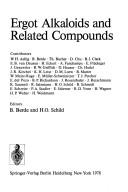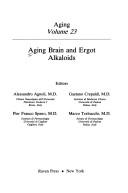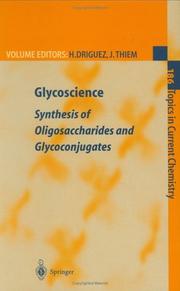| Listing 1 - 10 of 21 | << page >> |
Sort by
|
Book
ISBN: 0444987673 Year: 1990 Volume: 12 Publisher: Amsterdam : Elsevier,
Abstract | Keywords | Export | Availability | Bookmark
 Loading...
Loading...Choose an application
- Reference Manager
- EndNote
- RefWorks (Direct export to RefWorks)
Article
Year: 2000
Abstract | Keywords | Export | Availability | Bookmark
 Loading...
Loading...Choose an application
- Reference Manager
- EndNote
- RefWorks (Direct export to RefWorks)
Book
ISBN: 9782889195510 Year: 2015 Publisher: Frontiers Media SA
Abstract | Keywords | Export | Availability | Bookmark
 Loading...
Loading...Choose an application
- Reference Manager
- EndNote
- RefWorks (Direct export to RefWorks)
Ergot alkaloids produced by fungi have a basic chemical structure but different chemical moieties at substituent sites resulting in various forms of alkaloids that are distinguishable from one another. Since the ergoline ring structure found in ergot alkaloids is similar to that of biogenic amines (neurotransmitters), a variety of physiological effects can result after ingestion. Research involving ergot alkaloids is an increasing important global issue as more governments pass laws that limit permissible levels of ergot alkaloids in both foodstuffs and feedstuffs. Regardless of whether these compounds are found directly in foodstuffs or in feed/plants given to forage animals (i.e., cattle, sheep, horses, and goats), introduction of these compounds can complicate the food supply. In addition, toxicosis resulting from alkaloids can be a costly hindrance, with mounting annual production losses associated with forage-animal production systems that impact other agricultural and food based industries. Recent advances for the analysis of these compounds in different matrices as well as the understanding the role these compounds play in biological pathways have begun to help address the issue. The proposed Research Topic “Recent Investigations of Ergot Alkaloids Incorporated into Plant and/or Animal Systems“ will develop a forum where different groups can share recent data where their investigations could include (but are not limited to) how ergot alkaloids: i) influence specific biologic pathways in plant and/or animal systems when introduced, ii) were analyzed in either in biological matrices (e.g. food / feed, blood, urine, etc.), and/or iii) are distributed throughout materials, specifically in plant and/or animal tissues. Each publication must include a description of the methodologies used with the results gained. Inter- and multi-disciplinary approach to this field is desired and would be beneficial in this Research Topic.
Ergot alkaloids. --- Food supply --- Adrenergic alpha blockers --- Alkaloids --- Ergot --- Food control --- Produce trade --- Agriculture --- Food security --- Single cell proteins --- Toxicosis --- fungus --- Animal science --- Ergot Alkaloids --- Ergotism --- plant science

ISBN: 3540084754 0387084754 0354084754 3642667775 3642667759 Year: 1978 Volume: 49 Publisher: Berlin
Abstract | Keywords | Export | Availability | Bookmark
 Loading...
Loading...Choose an application
- Reference Manager
- EndNote
- RefWorks (Direct export to RefWorks)
Pharmacognosy --- Ergot Alkaloids. --- Ergot. --- Alkaloids. --- Alcaloïdes --- Ergot Alkaloids --- Pharmaceutical Preparations --- Pharmacology --- Biological Science Disciplines --- Pharmacology, Clinical --- Toxicology --- 547.94 --- Clavine Alkaloids --- Alkaloids, Clavine --- Alkaloids, Ergot --- Natural alkaloids. Alkaloids of unknown composition --- Ergot alkaloids --- 547.94 Natural alkaloids. Alkaloids of unknown composition --- Ergot alkaloids. --- Alcaloïdes

ISBN: 0890048533 Year: 1983 Publisher: New York (N.Y.): Raven
Abstract | Keywords | Export | Availability | Bookmark
 Loading...
Loading...Choose an application
- Reference Manager
- EndNote
- RefWorks (Direct export to RefWorks)
Brain chemistry --- Brain --- Ergot alkaloids --- Aging --- Diseases --- Age factors --- Physiological effect
Book
ISSN: 0250863X ISBN: 9241571055 Year: 1990 Volume: vol 105 Publisher: Geneva WHO
Abstract | Keywords | Export | Availability | Bookmark
 Loading...
Loading...Choose an application
- Reference Manager
- EndNote
- RefWorks (Direct export to RefWorks)
Ergot Alkaloids --- Ochratoxins --- Trichothecenes --- 615.9 --- 615.918:582.28 --- 632.95.024 --- 614.878 --- 614.833 --- $?$90/12
Book
ISBN: 9782130842835 Year: 2023 Publisher: Paris : Presses Universitaires de France : Humensis,
Abstract | Keywords | Export | Availability | Bookmark
 Loading...
Loading...Choose an application
- Reference Manager
- EndNote
- RefWorks (Direct export to RefWorks)
Bien avant les années 1960, qui ont marqué l'invasion du LSD dans les sphères artistiques et hippies, l'ergot de seigle, champignon parasite dont est issue cette puissante drogue hallucinogène, a causé des millions de morts au cours des siècles. Alors que le pain a longtemps constitué la base de l'alimentation, sa consommation n'a pas toujours été sans risques. L'ingestion de seigle contaminé est à l'origine du terrible mal des ardents, occasionnant des souffrances insoutenables pour les malades, rongés par la gangrène ou pris de convulsions. La toxicité de l'ergot a été élucidée au XVIIIe siècle, et ses principes actifs, les alcaloïdes, découverts au XXe siècle. Après des décennies d'expérimentations, on en a tiré une drogue psychoactive redoutable, le LSD. Des mystères d'Éleusis à l'affaire du pain maudit de Pont-Saint-Esprit, Jean Vitaux restitue et analyse l'histoire insolite de la pire mycotoxicose que l'humanité a jamais connue.
Ergot de seigle --- Ergotisme --- LSD (drogue) --- Champignons vénéneux --- Champignons hallucinogènes --- Alcaloïdes de l'ergot --- Hallucinogènes --- Mycotoxicoses --- Maladies. --- Emploi en thérapeutique. --- Toxicologie. --- Toxicologie --- Effets psychotropes. --- Aspect médical. --- Physiopathologie. --- Ergot. --- Mycotoxicoses. --- Ergotism. --- LSD (Drug) --- Mushrooms, Poisonous. --- Mushrooms, Hallucinogenic. --- Ergot alkaloids.

ISBN: 3540620338 3540496297 9783540620334 Year: 1997 Volume: 186 Publisher: Berlin: Springer,
Abstract | Keywords | Export | Availability | Bookmark
 Loading...
Loading...Choose an application
- Reference Manager
- EndNote
- RefWorks (Direct export to RefWorks)
This book presents the state of the art in the synthesis very complex saccharide structures, written by leading scientists at the forefront of this rapidly growing field. Reflecting the particular significance in recent years of efficient and selective procedures employing enzymes for preparative purposes in the carbohydrate field, a major proportion of the articles focus on these biocatalytic methods. In addition, recent strategies for the construction of unusual carbohydrates structures employing novel and creative methodologies are highlighted. Further, particular emphasis is placed on very complex saccharide structures as well as on special solutions to problems that are particularly challenging.
Carbohydrates --- Oligosaccharides --- Glycoconjugates --- Glycoconjugués --- Synthesis. --- Synthèse. --- Chemistry. --- Organic chemistry. --- Biochemistry. --- Organic Chemistry. --- Biochemistry, general. --- Glycoconjugués --- Synthèse. --- Biological chemistry --- Chemical composition of organisms --- Organisms --- Physiological chemistry --- Biology --- Chemistry --- Medical sciences --- Organic chemistry --- Composition --- Carbohydrates - Synthesis. --- Oligosaccharides - Synthesis. --- Glycoconjugates - Synthesis. --- OLIGOSACCHARIDES --- OLIGOSACCHARIDES, CONJUGATES --- GLYCOSIDE HYDROLASES --- LIPASES --- SIALIC ACIDS --- GLYCOSYLATION --- GLYCOPEPTIDES --- ERGOT ALKALOIDS --- PREPARATION
Book
ISBN: 0252080769 9780252039195 9780252080760 9780252097232 0252097238 025203919X Year: 2015 Publisher: Urbana, [Illinois] : University of Illinois Press,
Abstract | Keywords | Export | Availability | Bookmark
 Loading...
Loading...Choose an application
- Reference Manager
- EndNote
- RefWorks (Direct export to RefWorks)
"Now synonymous with Sixties counterculture, LSD actually entered the American consciousness via the mainstream. Time and Life, messengers of lumpen-American respectability, trumpeted its grand arrival in a postwar landscape scoured of alluring descriptions of drug use while outlets across the media landscape piggybacked on their coverage with stories by turns sensationalized and glowing. Acid Hype offers the untold tale of LSD's wild journey from Brylcreem and Ivory soap to incense and peppermints. As Stephen Siff shows, the early attention lavished on the drug by the news media glorified its use in treatments for mental illness but also its status as a mystical--yet legitimate--gateway to exploring the unconscious mind. Siff's history takes readers to the center of how popular media hyped psychedelic drugs in a constantly shifting legal and social environment, producing an intricate relationship between drugs and media experience that came to define contemporary pop culture. It also traces how the breathless coverage of LSD gave way to a textbook moral panic, transforming yesterday's refined seeker of truths into an acid casualty splayed out beyond the fringe of polite society. "--
SOCIAL SCIENCE / Popular Culture. --- SOCIAL SCIENCE / Media Studies. --- LSD (Drug) --- Hallucinogenic drugs --- Drugs and mass media. --- Acid (Drug) --- Lysergic acid diethylamide --- Lysergide --- Diethylamine --- Ergot alkaloids --- Serotonin --- Consciousness-expanding drugs --- Hallucinogens --- Mind-distorting drugs --- Psychedelic drugs --- Psychotomimetic drugs --- Psychotropic drugs --- Drug abuse in mass media --- Mass media and drugs --- Drug abuse --- Mass media --- Social aspects --- History --- Antagonists
Book

ISBN: 0773556028 9780773556027 9780773556034 0773556036 9780773555068 0773555064 Year: 2018 Publisher: Montreal : McGill-Queen's University Press,
Abstract | Keywords | Export | Availability | Bookmark
 Loading...
Loading...Choose an application
- Reference Manager
- EndNote
- RefWorks (Direct export to RefWorks)
Aldous Huxley (1894–1963) was the author of nearly fifty books and numerous essays, best known for his dystopian novel Brave New World. Humphry Osmond (1917–2004) was a British-trained psychiatrist interested in the biological nature of mental illness and the potential for psychedelic drugs to treat psychoses, especially schizophrenia. In 1953, Huxley sent an appreciative note to Osmond about an article he and a colleague had published on their experiments with mescaline, which inspired an initial meeting and decade-long correspondence. This critical edition provides the complete Huxley-Osmond correspondence, chronicling an exchange between two brilliant thinkers who explored such subjects as psychedelics, the visionary experience, the nature of mind, human potentialities, schizophrenia, death and dying, Indigenous rituals and consciousness, socialism, capitalism, totalitarianism, power and authority, and human evolution. There are references to mutual friends, colleagues, and eminent figures of the day, as well as details about both men's personal lives. The letters bear witness to the development of mind-altering drugs aimed at discovering the mechanisms of mental illness and eventually its treatment. A detailed introduction situates the letters in their historical, social, and literary context, explores how Huxley and Osmond first coined the term "psychedelic," contextualizes their work in mid-century psychiatry, and reflects on their legacy as contributors to the science of mind-altering substances. Psychedelic Prophets is an extraordinary record of a full correspondence between two leading minds and a testament to friendship, intellectualism, empathy, and tolerance. The fact that these sentiments emerge so clearly from the letters, at a historical moment best known for polarizing ideological conflict, threats of nuclear war, and the rise of post-modernism, reveals much about the personalities of the authors and the persistence of these themes today.Aldous Huxley (1894–1963) was the author of nearly fifty books and numerous essays, best known for his dystopian novel Brave New World. Humphry Osmond (1917–2004) was a British-trained psychiatrist interested in the biological nature of mental illness and the potential for psychedelic drugs to treat psychoses, especially schizophrenia. In 1953, Huxley sent an appreciative note to Osmond about an article he and a colleague had published on their experiments with mescaline, which inspired an initial meeting and decade-long correspondence. This critical edition provides the complete Huxley-Osmond correspondence, chronicling an exchange between two brilliant thinkers who explored such subjects as psychedelics, the visionary experience, the nature of mind, human potentialities, schizophrenia, death and dying, Indigenous rituals and consciousness, socialism, capitalism, totalitarianism, power and authority, and human evolution. There are references to mutual friends, colleagues, and eminent figures of the day, as well as details about both men's personal lives. The letters bear witness to the development of mind-altering drugs aimed at discovering the mechanisms of mental illness and eventually its treatment. A detailed introduction situates the letters in their historical, social, and literary context, explores how Huxley and Osmond first coined the term "psychedelic," contextualizes their work in mid-century psychiatry, and reflects on their legacy as contributors to the science of mind-altering substances. Psychedelic Prophets is an extraordinary record of a full correspondence between two leading minds and a testament to friendship, intellectualism, empathy, and tolerance. The fact that these sentiments emerge so clearly from the letters, at a historical moment best known for polarizing ideological conflict, threats of nuclear war, and the rise of post-modernism, reveals much about the personalities of the authors and the persistence of these themes today.
Authors, English --- Psychiatrists --- Hallucinogenic drugs --- LSD (Drug) --- Schizophrenia --- Mental illness --- Psychiatry --- Acid (Drug) --- Lysergic acid diethylamide --- Lysergide --- Diethylamine --- Ergot alkaloids --- Serotonin --- Consciousness-expanding drugs --- Hallucinogens --- Mind-distorting drugs --- Psychedelic drugs --- Psychotomimetic drugs --- Psychotropic drugs --- Alienists --- Psychopathologists --- Mental health personnel --- Physicians --- Neurologists --- Therapeutic use. --- Therapeutic use --- Treatment. --- Treatment --- Antagonists --- Huxley, Aldous, --- Osmond, Humphry --- Osmond, H. --- Huxley, Aldous Leonard --- Huxley, Aldous --- Huxley, Aldous Leonard, --- Khŭksli, Oldŭs, --- Хъксли, Олдъс, --- Khaksli, Oldos, --- Хаксли, Олдос, --- Хаксли, О. --- האקסליי, אלדוס, --- הקסלי, אלדוס,
| Listing 1 - 10 of 21 | << page >> |
Sort by
|

 Search
Search Feedback
Feedback About UniCat
About UniCat  Help
Help News
News